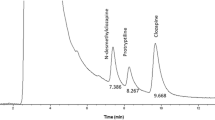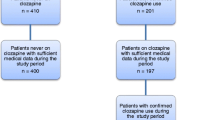Abstract
Rationale: The atypical antipsychotic clozapine is effective in the treatment of patients with refractory schizophrenia. It carries a well-known risk of neutropenia and agranulocytosis, which necessitates the immediate discontinuation of clozapine. Objective: We report a patient who developed neutropenia on clozapine, but behind the cell count decrease showed to be a diurnal variation of the white blood cells (WBC). Methods: Due to the lack of efficacy of subsequent treatment of conventional and other atypical neuroleptics, treatment with clozapine was restarted after discontinuation. When the morning count of WBC began to fall, WBC count was repeated in the afternoons. Results: Careful blood cell monitoring showed a pronounced diurnal variation of WBC (2.9–4.2×109/l in the morning and 3.6–7.1×109/l in the afternoon) and granulocytes (0.8–1.4×109/l and 2.9–5.5×109/l, respectively). Conclusions: Some patients may thus have a spuriously low cell count and may be unnecessarily denied effective treatment.
Similar content being viewed by others
Author information
Authors and Affiliations
Additional information
Received: 10 February 1999 / Final version: 22 March 1999
Rights and permissions
About this article
Cite this article
Ahokas, A., Elonen, E. Circadian rhythm of white blood cells during clozapine treatment. Psychopharmacology 144, 301–302 (1999). https://doi.org/10.1007/s002130051008
Issue Date:
DOI: https://doi.org/10.1007/s002130051008




